This was published 8 years ago
Vietnam and Cambodia, Mekong cruise: One river, many worlds
By Alison Stewart
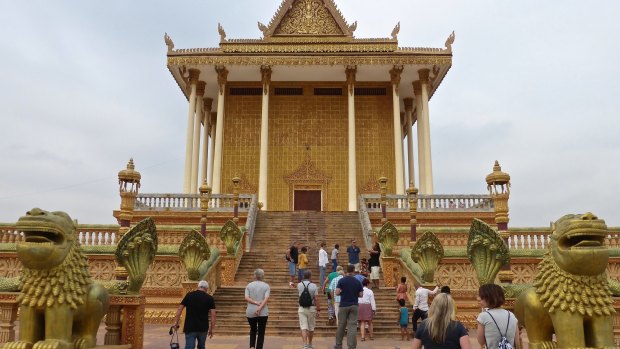
Oudong Pagoda.Credit: Rob Mills
Immersed in the complex water world of the Mekong river people, we glide noiselessly through south-east Asian history, politics, cuisine and culture. Noiselessly, because the silent motion of our cruise vessel, Scenic Spirit, the newest and possibly most luxurious on the Mekong, means we enter and leave a rich variety of magical worlds with little impact, gathering the river's stories as we go. Sometimes we must look overboard to see that we're actually moving.
If it were possible for a river to have wisdom, the Mekong would be one of the world's wisest waterways. It has swept from the Tibetan highlands to the sea for millennia, gathering tales of treachery, wisdom, suffering and prosperity. It's our turn to travel the river, absorbing some of those tales. "Are you in a total bubble of luxury?" a friend asks of our Treasures of the Mekong cruise through Cambodia and Vietnam. Not at all.
Like modern-day explorers – taking advantage of Scenic's "enrich" and "free choice" experiences – we forge out from the ship into exotic, often untouristy environs, meeting people and hearing about their experiences, hardships and dreams.
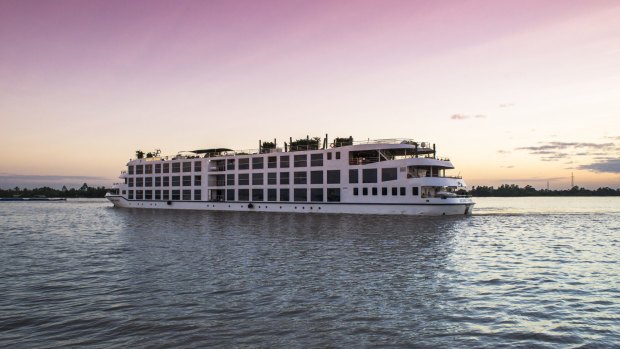
Scenic Spirit
We travel through lush landscapes, trying to understand the intricate cultures that have produced the gods, temples and cities rising from the jungles. We meet saffron-robed monks, silk-weavers, silversmiths, stonecutters, farmers, survivors of Pol Pot's regime, children practising their English, even a distressed young nun seeking family who fled war-torn Cambodia for the US.
We taste snake wine, Vietnamese coffee, lotus tea and durian, examine market delicacies like gutted rats and snakes, watch a Khmer shadow puppet show, dance Gangnam-style in a karaoke bar, buy some excellent Saigon Prada knock-offs, learn how to tie a Cambodian krama (garment), ride an ox-wagon, fondle a python, have high tea at Phnom Penh's Raffles Le Royal Hotel and taste Sombai-flavoured rice wines.
We visit museums, monasteries, rural villages, bustling markets, French colonial mansions, palaces, wildlife sanctuaries, traditional Khmer and Vietnamese eating places, the ancient shrines of Oudong and, a sombre necessity, the Killing Fields and S-21 genocide museum.
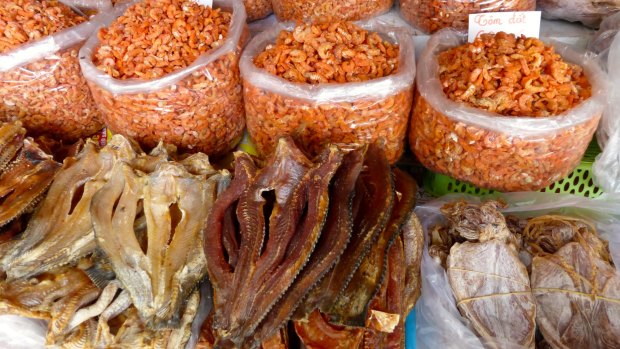
Sa Dec markets.Credit: Rob Mills
Sometimes it's confronting, as it should be, for the people of these two complex countries fought over for centuries have suffered more than anyone ever should, their cultures as fluid as the river that often defines them. Cambodia is still one of the world's poorest countries.
And it is true that we can retreat to our first-world cocoon of butlers, French champagne, exquisite meals, Spotify-enabled dance nights, massages, manicures, luxurious suites, cold drinks and refreshing hand towels on re-boarding. But most take the opportunity to step ashore, appreciating that a deeper knowledge of others' experiences is a critical element of travel.
During the seven days of our watery journey from Cambodia's Siem Reap, down the last stretch of the 4350-kilometre Mekong via Cambodia's capital Phnom Penh to the Delta city of Ho Chi Minh (still Saigon to the locals), we learn much about the people of these strategic countries still struggling towards greater democracy.
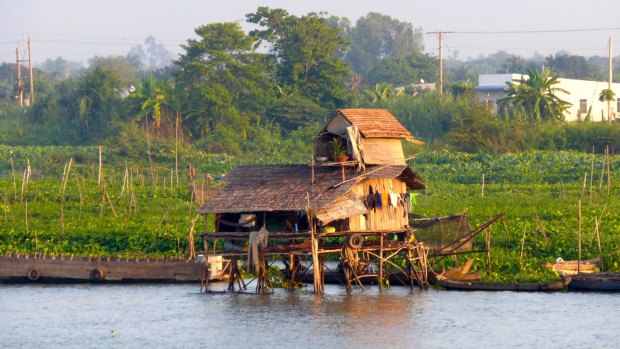
Stilt home on the Mekong.Credit: Alison Stewart
Our Cambodian and Vietnamese guides and the ship staff need special mention because they are the searingly honest filters through which we glean knowledge. Facts are often tempered by personal experience.
The ship's hospitality team is Cambodian – 400 people applied for only 40 positions – so this is the cream of the crop, similarly with the guides. Their dedication, charm and exuberance is more remarkable given most of their families have been touched by the brutal civil war years of Pol Pot's Khmer Rouge which saw more than two million people murdered – Khmer Rouge genocide hearings continue to this day.
One spent his first nine years in the jungle. Another still prays that his uncles, lost to the Khmer Rouge, will return. Another recalls a starving childhood – rice was luxury; there was only tapioca. Another slept in haystacks for warmth. There is no self-pity; simply gratitude that life resumes.
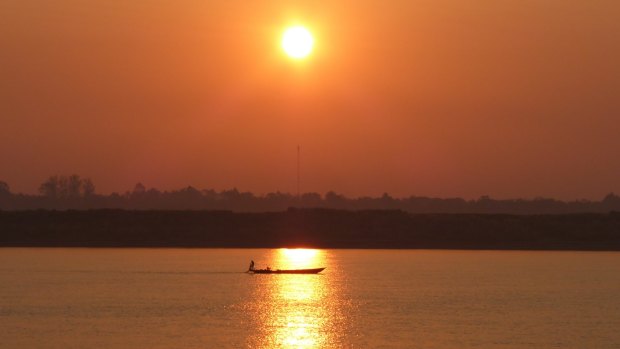
Sunset fishing on the Mekong.Credit: Alison Stewart
Yet dark clouds persist, specifically the fate of the mighty Mekong. The river flows through six countries, providing food and livelihoods to the river people since 7000 BC (and still does for 60 million people).
But the Mekong faces multi-pronged threats, the most serious being dam construction in China, Laos and Cambodia. Dams impact river flow, water quality, sedimentation, fish migration and cause community displacement.
The Mekong Delta, home to 17 million and the country's rice bowl, producing almost half Vietnam's rice and 60 per cent of fish, is especially vulnerable. As is Cambodia's Mekong-fed Tonle Sap (lake), which yields 70 per cent of the country's fish protein – six million of the country's 15 million population are fisher folk.
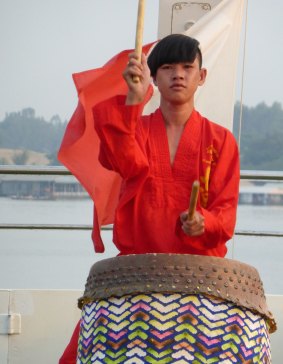
Vietnamese lion dance.Credit: Alison Stewart
Initially, we know little of this as we tuck in to our sumptuous breakfast of excellent coffee, pastries and tropical fruit in Siem Reap's Park Hyatt, preparing to walk the local markets before embarking on our cruise.
Observations as we negotiate the Cambodian countryside reveal it to be thirsty for the imminent monsoon. It's rice harvest time, the grains spread for drying, the Japanese water buffalo (Toyota tractors) replacing the real thing.
Village life is still traditional – ochre and blue stilt houses with their terracotta tiles, surrounded by mango, papaya, coconuts, bananas and sugar palms with bamboo ladders attached to aid harvest.
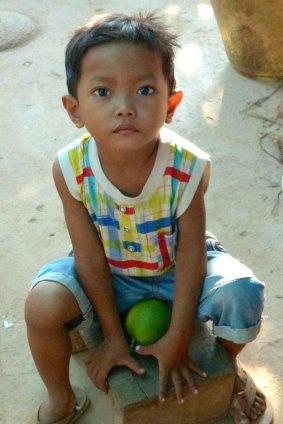
Boy at Koh Chen silversmith village.Credit: Alison Stewart
By the road, braziers flame sticks of bamboo stuffed with coconut, salt, sugar and kidney beans, the equivalent of the barbecued mice on sticks sold by the roadside in Malawi.
Yet there is the ever-present bridge between past and present – Cambodia's 20,000 mass gravesites from the time of killing and the still present unexploded mines. We experience both the beauty of Phnom Pros and Phnom Srei with their architectural pagodas and Buddha statues but also the sadness of a small stupa with its mound of skulls – legacy of the nearby Kampong Cham killing fields.
The landscape becomes lusher as we cross the border into Vietnam and enter the water world of the delta and the tributaries of what the Vietnamese call Nine Dragons River.
In between our visits to the delta's floating villages and markets, our guide explains that every Vietnamese family has been touched by war, that more than half of Vietnam's history is war, but people have worked hard towards that "dreaming place" of peace and prosperity.
We also learn never to walk through a durian orchard at night – that's when the fruit drops!
Our gorgeous grand deluxe suite with its restful pale wood floors, dark wood, leather, and wicker furniture with chocolate, silver and caramel hues is a cool retreat after jam-packed days. Through its gigantic electronic windows, we watch the river life slide past.
Our cheerful butler, Phearon, keeps our minibar stocked and delivers Khmer burgers or Hanoi grilled chicken banh mi for lunch. Along the corridor is the pool deck for a quick plunge or a Mekong Manhattan. And there's always time for a traditional Khmer massage under the magic hands of the spa staff, in my case, Thearoth.
Dinner is a highlight – drinks first on the pool deck then a table for eight to catch up with friends, share stories and sample executive chef Ario Prananda's four-course fine-dining artworks, which might include soft crab tempura with stir fried vegetables, broken fried rice and nuoc cham or warm aromatic duck breast with sticky turmeric rice, passion and jackfruit. We are indeed fortunate.
That's the Spirit: a life of luxury
The ceremonial champagne is barely dry on the bow of Scenic Spirit, Scenic's luxury all-inclusive 68-passenger, 34-suite river cruise ship that is more like a five-star floating hotel.
Launched earlier this year, this "next generation" Mekong ship with its intimate boutique environment has made only a handful of seven-night river journeys between Saigon and Siem Reap. It offers a level of service unique in Cambodia, according to the ship's French hotel director, Baptiste Cabarry.
European river ships must strictly comply with standardised designs but here on the Mekong, the ship's designers have been free to create the vessel of their dreams. According to project engineer Ivo Skelin, they have combined the safety and luxury of European ships with Asian feel and contemporary style.
The Scenic Spirit is an 85-metre-long, five-deck ship with lift that offers some of the largest all-balcony, butlered, one-bedroom suites on the river. The smallest cabin – the deluxe suite – is 32 square metres that Skelin says is "huge in some ships".
Twenty-four deluxe suites are spread between second-level Jewel, third-level Sapphire and fourth-level Diamond decks. They have private, full-length balconies with floor-to-ceiling, vertical sliding windows, walk-in wardrobes, ensuites with large vanities, separate toilet and shower and L'Occitane products.
Eight grand deluxe suites on Diamond deck measure 40 square metres with separate lounge and dining areas and extra-large walk-in wardrobes.
Also on Diamond deck are two forward-facing, 80-square-metre Royal Panorama suites – the largest on the Mekong. These also have a private terrace with outdoor jacuzzi and daybed, separate bath, toilet and shower.
All individually air-conditioned suites have minibars stocked daily, Evian water, 24-hour in-room dining, Scenic Slumber queen beds that are raised and lowered automatically, plus Egyptian cotton linen.
The Spirit has a spa, gym, sauna, steam room, guest laundry, eight-metre pool and pool-deck bar, open-air cinema and sun-deck bar, observation lounge and library, Spirit lounge, River cafe and bar and the beautiful Crystal dining room with open-seating tables for two to eight.
Indonesian executive chef Ario Prananda offers seasonal Asian-fusion menus, drawing on his years working in Europe and Dubai with Michelin-starred chefs.
Vegetables and fruit are organic and local, seafood is sourced locally, while lamb and beef comes from Australia. Water is triple-filtered, then treated with chemicals and ultraviolet, but Prananda still uses food purification tablets and bottled water.
Port charges, tipping and Wi-Fi are included.
The ship, designed with high-level manoeuvring capability and a "double bottom", is divided into watertight compartments. Even if one is flooded, it will stay afloat.
TRIP NOTES
MORE INFORMATION
CRUISING THERE
Treasures of the Mekong 13-day cruise from $6535 per person twin share. Travel in 2017 and fly free return to south-east Asia, saving up to $3070 per couple. Business-class upgrade from $2995 per person. Includes seven nights on board Scenic Spirit, visiting the colourful floating markets of Cai Be, the historic town of Sa Dec, and Cambodia's capital Phnom Penh. Plus three nights in Siem Reap, Cambodia and two in Ho Chi Minh City, Vietnam. See www.scenic.com.au/
GETTING THERE
Vietnam Airlines flies from Sydney and Melbourne to Ho Chi Minh City (8h45min), then connects to Siem Reap (1hr). See https://www.www.vietnamairlines.com.
Alison Stewart was a guest of Scenic
Sign up for the Traveller Deals newsletter
Get exclusive travel deals delivered straight to your inbox. Sign up now.